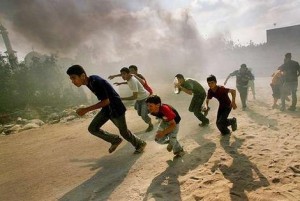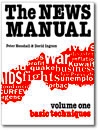DogBitesMan » Journalism » Can journalism survive modern media warfare?
Can journalism survive modern media warfare?
If truth really is the first casualty of war, is journalism itself among the victims of the conflict in Gaza? If truth suffers in the charged atmosphere of death and destruction, can proper professional and ethical objective journalism survive intact and can journalists – the truthmongers – still tell war’s stories fairly and accurately for the rest of us to understand?
It is a question many thoughtful journalists have asked over the years from places as far afield as the Boer Republic in South Africa to the river deltas of Vietnam, from the steppes of Stalingrad to the jungles of Rwanda.
More pertinent to the present conflict in Gaza, journalists have been pondering this issue for years. Writing during a similar conflict in Lebanon two years ago, John Pilger and Robert Fisk came up with sobering answers.
Of the conflict between Israel and the Hezbollah, in July 2006 Fisk wrote in The Independent: “As many lies are now falling upon Lebanon as bombs. The explosions are easy to count … The lies were less obvious but just as powerful.”1
Two months earlier, Pilger had written in New Statesman: “The oldest cliché is that truth is the first casualty of war. I disagree. Journalism is the first casualty.”
Pilger, who has been fearless – some say care less – over many years in criticising the media, accused western journalists of “servility to the state”, of parroting government propaganda and failing to resist what he called “a virulent censorship” and “censorship by omission, whose power is such that, in war, it can mean the difference between life and death for people in faraway countries.”2
Pilger was writing about many wars including Lebanon and Iraq, but doubtless he and others like him who care about journalism would see the war in Gaza is just the latest to test the mettle of our profession.
As with all previous conflicts covered by the media, there have been some notable heroes and also some who were found wanting. At least four Palestinian journalists had been killed since the resumption of full-scale hostilities on 27 December 2008, numerous journalists from around the world have risked their lives to find the truth and tell it to the people back home – and some have fallen victim to efforts by both Israel and Hamas to manipulate shocking atrocities to their own ends.
Of course, it is easy to sit thousands of miles from Gaza and judge the journalists covering the terrible events unfolding there. War reporting has seldom been easy. It is dangerous, dirty and confusing work, full of terror and lies, not at all the glamorous occupation portrayed in novels and movies. That’s why, over the years, many of the world’s leading practitioners have chosen to stay clear of the actual battlefields and try to get some perspective in the slightly clearer air behind the battle lines.
There is an old adage that sometimes one cannot see the forest for the trees, being too close to individual parts to see how they fit into the whole. It is important to tell the stories of the Palestinian women and children killed by Israeli airstrikes or the Jewish families huddling in terror as Hamas rockets fall on them. These are important stories. But when the total number killed reaches 1,000, a larger imperative asserts itself. Journalists must, by calm and measured reporting, explain the ‘why?’ of the conflict and the ‘how?’ it might be ended.
They are, of course, not helped by the fact that both the Israeli government and Hamas are fighting this war on two fronts – on the streets of Ashkelon and Gaza City and also in the world media.
As with the flesh-and-bloodshed war itself, the Israeli media blitz is bigger, better organised and more sophisticated.3
In the two years since the public relations disaster of the war against Hezbollah in Lebanon, they have reorganised their whole media approach, setting up a centralised National Information Directorate and employing articulate, sophisticated and seemingly concerned professionals to spread their hasbara – Hebrew for “explanation” – to local and international media hungry for information and comment. They brief retired generals to speak with authority in interviews and they use YouTube to distribute military surveillance videos of Hamas fiendishness.4
And where they can’t control the story, they exclude the story tellers, banning both Israeli and foreign journalists from Gaza, ostensibly for their own safety or for operational reasons.5
It is little more than the Americans did during the invasion of Iraq, then embedding chosen journalists with their units, but Iraq is a much larger country and journalists there found their own ways round these restrictions to report on things the Coalition did not want them to see.
Ironically, of course, the Israeli media strategy is in great danger of backfiring. Frustrated journalists become suspicious of things they are not allowed to see and all the more eager to get into places from which they are banned. Journalists are – and should be – cynical creatures and so they ascribe the worst motives to such bans.
They also call on the services of colleagues who are able to get into Gaza, employing local Palestinians reporters and camera crews or interviewing Gaza residents by telephone, people hardly likely to support Israel.
But Hamas too is fighting a media war. It has been accused of taunting its enraged enemy to continue to bomb and shell schools and mosques by firing rockets from within or beside them. Hamas appeals to the world as the victim of Israeli aggression but no more wants to present a balanced picture of the fighting than do the Israelis.
Amidst all this chaos and deception, journalists must toil to harvest bits and pieces of truth then blend them into some coherent dish to feed the world’s insatiable appetite for the latest news from the newest of our wars.
Some journalists don’t bother. Some, like the Sydney Morning Herald’s conservative columnist Paul Sheehan, accept free trips to the Middle East as guests of the Israeli government then return to disgorge the feast of hasbara they’ve been fed – without telling their readers.
Thankfully for the profession, they are not typical.
The vast majority of journalists covering conflicts such as Gaza simply try to do their job as best they can. They know that once a journalist has pawned his or her reputation, it cannot be redeemed.
So journalism will muddle through, guided by the faint glow of our professional ethic and a basic human impulse to be fair. It will be wounded by the enemies of truth and sustain a few self-inflicted wounds. Real journalists will suffer and some will die. But the profession will survive.
First published in The News Manual in January 2009
SOURCES:
1. Once again, truth is the first casualty of war, The Independent, 22 July 2006
2. The real first casualty of war, New Statesman, 24 April 2006
3. Israel mounts PR campaign to blame Hamas for Gaza destruction, The Guardian, 28 December 2008
4. Israel takes battle with Hamas to YouTube, Sydney Morning Herald, 1 January 2009
5. Israel keeps ban on foreign journalists in Gaza, Associated Press, 2 Jan 2009
__________
You can read more on some of the practical and ethical aspects of journalism in times of conflict in the following chapters of The News Manual:
Chapter 42: Death & disaster, introduction
Chapter 43: Reporting death & disaster
Chapter 56: Facts and opinions
Chapter 57: Fairness
Chapter 58: Pressures on journalists
Filed under: Journalism














